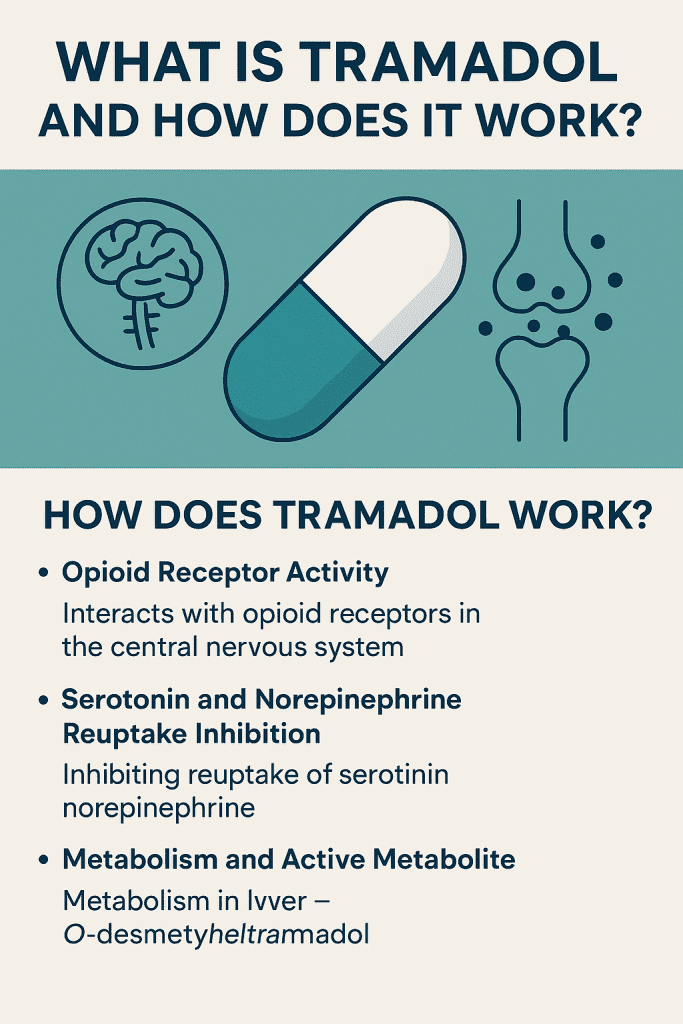Last Updated on October 7, 2025
What Is Tramadol and How Does It Work?
Tramadol is a prescription medication used to manage moderate to moderately severe pain. While it is classified as an opioid analgesic, its unique pharmacological properties set it apart from traditional opioids like morphine or oxycodone.Understanding how tramadol works is crucial for both patients and healthcare providers to ensure safe and effective pain management.
What Is Tramadol?
Tramadol is a synthetic opioid analgesic that was first approved for medical use in the 1990s. It is commonly prescribed for conditions such as post-surgical pain, osteoarthritis, and fibromyalgia. Unlike stronger opioids, tramadol is considered to have a lower potential for abuse and dependence, though these risks are not negligible.
Related: Other pain meds to know: meloxicam (NSAID) — uses and risks.
How Does Tramadol Work?
Opioid Receptor Activity
Tramadol’s primary mechanism of action involves its interaction with opioid receptors in the central nervous system. It binds to the μ-opioid receptor, though with much lower affinity compared to potent opioids like morphine. This interaction helps to alleviate pain by modulating pain signals in the brain and spinal cord.
Serotonin and Norepinephrine Reuptake Inhibition
In addition to its opioid receptor activity, tramadol inhibits the reuptake of serotonin and norepinephrine, two neurotransmitters involved in pain modulation. By increasing the levels of these neurotransmitters in the synaptic cleft, tramadol enhances descending inhibitory pathways that reduce pain perception.
Metabolism and Active Metabolite
Tramadol is metabolized in the liver by cytochrome P450 enzymes, primarily CYP2D6 and CYP3A4. One of its active metabolites, O-desmethyltramadol (M1), has a significantly higher affinity for the μ-opioid receptor than tramadol itself, contributing to its analgesic effects. However, the formation of this metabolite can vary among individuals due to genetic differences in enzyme activity, leading to variability in pain relief and side effects.
Clinical Uses of Tramadol
Pain Management
Tramadol is primarily used for the management of moderate to moderately severe pain. It is often prescribed after surgeries or for chronic conditions like osteoarthritis. Its dual mechanism of action—opioid receptor binding and neurotransmitter reuptake inhibition—makes it effective for a wide range of pain types.
Off-Label Uses
Beyond its approved indications, tramadol has been used off-label for conditions such as restless leg syndrome, fibromyalgia, and as an adjunct in the treatment of depression. However, these uses should be approached with caution and under strict medical supervision due to the potential for side effects and dependence.
Side Effects and Risks
Common Side Effects
Tramadol can cause side effects, including:
-
Dizziness and drowsiness
-
Nausea and vomiting
-
Constipation
-
Headache
Serious Risks
More serious risks associated with tramadol include:
-
Seizures
-
Serotonin syndrome, especially when combined with other serotonergic drugs
-
Respiratory depression
-
Risk of addiction and dependence, particularly with long-term use
Drug Interactions
Tramadol can interact with various medications, including:
-
Antidepressants (SSRIs, SNRIs)
-
Benzodiazepines
-
Other opioids
-
CYP2D6 inhibitors
These interactions can increase the risk of adverse effects such as serotonin syndrome or respiratory depression.
Dependence and Withdrawal
While tramadol is considered to have a lower potential for abuse compared to other opioids, dependence can still develop, especially with prolonged use. Withdrawal symptoms may include anxiety, agitation, insomnia, and flu-like symptoms.Tapering the dose gradually under medical supervision is recommended to minimize withdrawal effects.
Treatment for Tramadol Addiction
For individuals struggling with tramadol addiction, treatment options include:
-
Medication-Assisted Treatment (MAT): Using medications to reduce cravings and withdrawal symptoms.
-
Inpatient Rehabilitation: Provides a structured environment for recovery.
-
Outpatient Programs: Allows individuals to receive treatment while maintaining daily responsibilities.
-
Therapy and Counseling: Addresses underlying psychological issues contributing to addiction.
It’s important to consult healthcare professionals to determine the most appropriate treatment plan.
Conclusion
Tramadol is a versatile analgesic with a unique mechanism of action that combines opioid receptor activity with neurotransmitter reuptake inhibition. While it offers effective pain relief for many individuals, it is not without risks.Understanding how tramadol works, its potential side effects, and the importance of adhering to prescribed dosages can help ensure its safe and effective use in pain management.
If you or someone you know is struggling with tramadol addiction, it’s crucial to seek professional help. Treatment is available, and recovery is possible with the right support and resources.
For more information on tramadol and its effects, consult reputable medical sources or speak with a healthcare provider.
Note: This article is for informational purposes only and should not be considered medical advice. Always consult with a healthcare professional before making any changes to your medication regimen.
Sources
[1] Tramadol. National Center for Biotechnology Information. (n.d.-a). https://www.ncbi.nlm.nih.gov/books/NBK537060/ on May 25, 2023
[2] Bumpus, J. A. (2020, October 29). Low-dose tramadol as an off-label antidepressant: A data mining analysis from the patients’ perspective. ACS pharmacology & translational science. https://www.ncbi.nlm.nih.gov/pmc/articles/PMC7737323/ on May 25, 2023
[3] Sansone, R. A., & Sansone, L. A. (2014, March). Serotonin norepinephrine reuptake inhibitors: A pharmacological comparison. Innovations in clinical neuroscience. https://www.ncbi.nlm.nih.gov/pmc/articles/PMC4008300/ on May 25, 2023
[4] Husic, S., Izic, S., Matic, S., & Sukalo, A. (2015, February). Efficacy and safety of a fixed combination of Tramadol and Paracetamol (acetaminophen) as pain therapy within Palliative Medicine. Materia socio-medica. https://www.ncbi.nlm.nih.gov/pmc/articles/PMC4384875/ on May 25, 2023
[5] Shah, K., Stout, B., & Caskey, H. (2020, July 11). Tramadol for the management of opioid withdrawal: A systematic review of randomized clinical trials. Cureus. https://www.ncbi.nlm.nih.gov/pmc/articles/PMC7417126/ on May 25, 2023
